Google Nexus 4 Review - Google's new Flagship
by Brian Klug on November 13, 2012 8:45 AM EST- Posted in
- Smartphones
- LG
- Android
- Mobile
- APQ8064
- Nexus 4
- Android 4.2
- MDM9215
Battery life in the Nexus 4 is a big concern for many, especially since the Nexus 4 isn’t designed to have a user replaceable battery. What’s inside is a 2100 mAh 3.8V battery which is 8.0 watt-hours. I had been wondering for a while what the chemical compound used in the 3.8V battery cells we’re seeing emerge was, and finally got a tad more info at least about the LG Chem approach. This is the higher voltage chemistry from LG Chem which is Lithium Cobalt Oxide (LiCoO2) based and includes electrolyte additives to prevent gas generation in the cell which affects lifetime during high temperature periods. Although getting the back off of the Nexus 4 is relatively easy and requires just removing two Torx 4 screws and prying up on the plastic, I doubt anyone is going to make a back to accommodate an extended battery due to the presence of 4 antennas which are integrated into the back cover.
The Nexus 4 incorporates wireless charging into that back alongside NFC. For wireless charging the Nexus 4 uses a TI BQ51051b wireless power Li-Ion charger receiver. I’ve been pretty remiss in looking into wireless charging and actually trying it myself, so I went ahead and bought a two-position Energizer Qi compliant charging mat.
The Nexus 4 is Qi 1.1 wireless charging forum compliant, so any charger that is Qi compliant or includes the logo will charge it. Aligning the Nexus 4 on the Energizer mat is a bit tricky since the surface is slick and angled down, and the back of the Nexus 4 is primarily glass, but it isn’t difficult after you know where to align. The Nexus 4 charges from fully discharged to completely charged in 3.033 hours on the Qi mat, which is basically the same charge time as I saw off of microUSB on a BC 1.2 charger.
In Android you’ll see Charging (Wireless) when this mode is employed. I used the Palm Pre touchstone charger a lot back in the day and saw that get pretty hot during a charge cycle. The Nexus 4 doesn’t get nearly as warm. I’ve noticed that at the top of the charge cycle you’ll see the Nexus 4 selectively draw power from the charging dock since there doesn’t seem to be an equivalent trickle charge mode or something, but this is normal.
Battery Life
I’ve had the chance to run more battery life tests on the Nexus 4, and run the cellular test a few more times. The results are quite consistent and we don’t see that result change very much at all. I’ve also added the call time test and tethering results.
We regularly load web pages at a fixed interval until the battery dies (all displays are calibrated to 200 nits as always). The differences between this test and our previous ones boil down to the amount of network activity and CPU load.
On the network side, we’ve done a lot more to prevent aggressive browser caching of our web pages. Some caching is important otherwise you end up with a baseband test, but it’s clear what we had previously wasn’t working. I’ve made sure that despite the increased network load, the baseband still has the opportunity to enter its idle state during the course of the benchmark, we’re not destroying the RRC states with too aggressive of a load time.
We also increased CPU workload along two vectors: we decreased pause time between web page loads and we shifted to full desktop web pages, some of which are very JS heavy. The end result is a CPU usage profile that mimics constant, heavy usage beyond just web browsing. Everything you do on your smartphone ends up causing CPU usage peaks - opening applications, navigating around the OS and of course using apps themselves. Our 5th generation web browsing battery life test should map well to more types of smartphone usage, not just idle content consumption of data from web pages.
As always we test across multiple air interfaces (3G, 4G LTE, WiFi), but due to the increased network load we actually find that on a given process technology we see an increase in battery life on faster network connections. The why is quite simple to understand: the faster a page is able to fully render, the quicker all components can drive down to their idle power states. All Android tests use Chrome and 5GHz WiFi unless otherwise listed.
The tethering test still consists of four tabs of the webpage tests in conjunction with a 128 kbps streaming MP3 radio station over the smartphone’s personal WiFi hotspot.
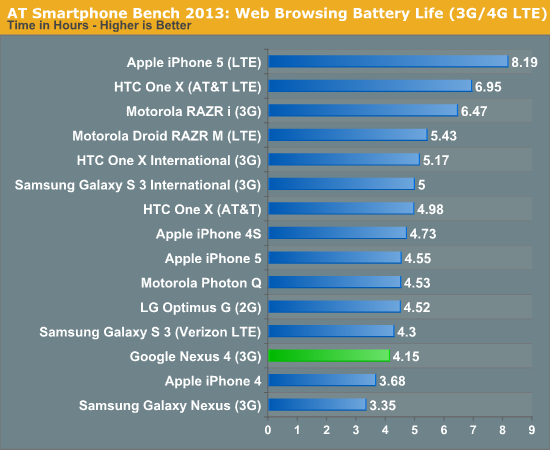
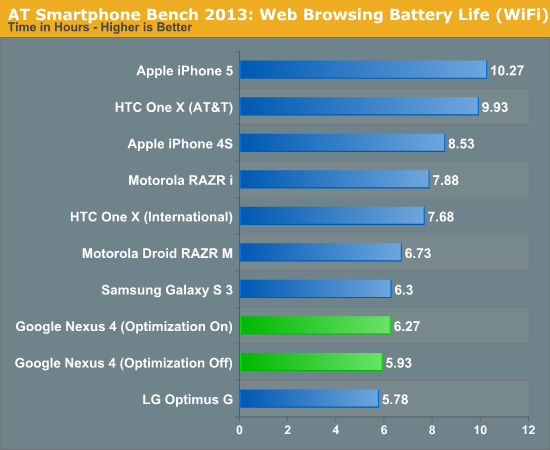
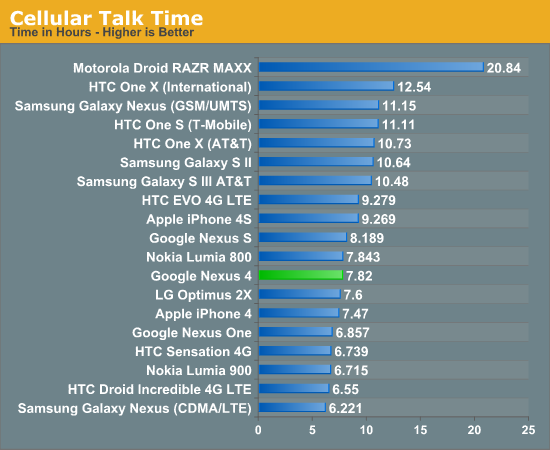
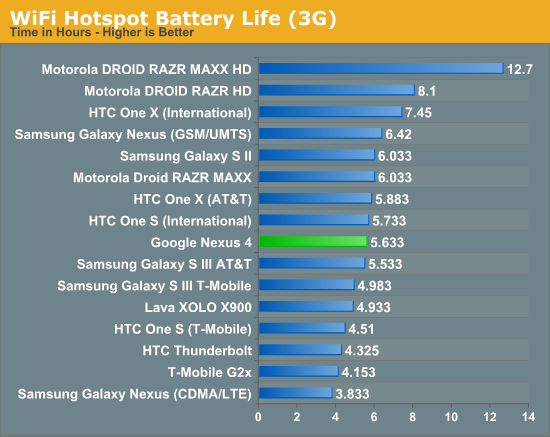
I've run and re-run the battery life tests on the Nexus 4 and they haven't changed since our preview a whole bunch. The result is battery life that isn't really chart topping, yet in my time with the Nexus 4 I haven't really been want for more battery life at any point. I'm able to get through a single day with the device set on auto brightness.



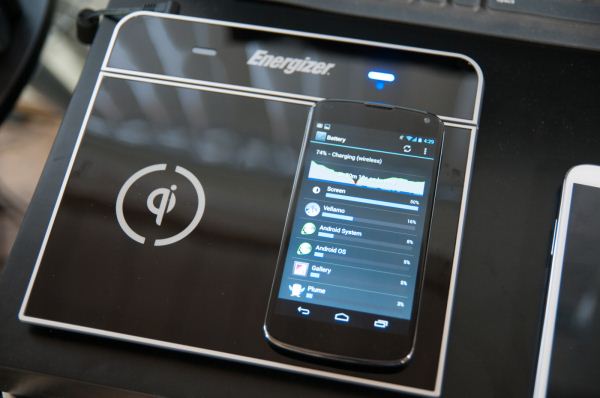

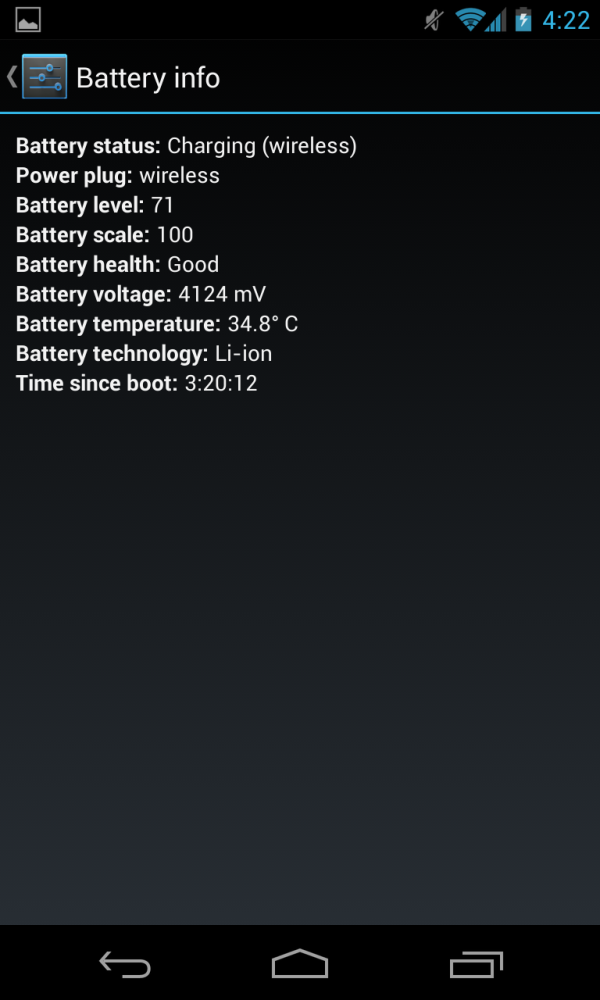








188 Comments
View All Comments
amdwilliam1985 - Tuesday, November 13, 2012 - link
These smart phones and tablets are the old computing devices that you used to love in a new form and shape.I can't remember the last time I got excited about "computer" hardware.
phillyry - Thursday, November 15, 2012 - link
+1A5 - Tuesday, November 13, 2012 - link
Intel, AMD, and Nvidia only really do 1 hardware launch a year now, the motherboards are all essentially the same, and driver reviews are borrrrrring to perform and read.They're still putting up like 3-4 case reviews a month, but there really isn't much else to talk about besides mobile stuff anymore.
Sabresiberian - Tuesday, November 13, 2012 - link
I don't read every article Anandtech publishes; in fact, if there is an article I just skim through, or skip entirely, it will be one about any kind of mobile computing, including smart phones. It doesn't bother me though that Anandtech spends as much time on these things as they do because they still do plenty of high quality articles on mainboards, CPUs, graphics cards, PSUs - the things I am interested in, and they have added editors to cover additional types of hardware, and, bottom line, I don't expect everything they publish to have me in mind.;)
Impulses - Tuesday, November 13, 2012 - link
They still do more in depth CPU and architecture articles than most sites, probably due in large part to Anand's knowledge and contacts. They've been doing a ton of case reviews too... Motherboards have been boring for quite a while. I don't think any of that content has suffered much. The one thing I'd say has suffered is GPU reviews, Anand does a great job of analyzing new architectures at times but their benchmark methods (and variety of tested resolutions) pale in comparison to other sites IMO.Impulses - Tuesday, November 13, 2012 - link
Not that I'm complaining mind you, there's other places to read about that stuff... However none of the quasi-blogs that cover the mobile industry do phone reviews as detailed and in depth as AT. Something as simple as standardized battery testing seems to elude the entire web outside of AT, at best you might find rundown tests with a movie or something lazy like that.tipoo - Tuesday, November 13, 2012 - link
It's just about speed of updates. There's a new top end smartphone every other day, while CPU architectures don't make big changes for up to two years and GPUs at least a year.phillyry - Thursday, November 15, 2012 - link
Home-made desktop PCs are verging on irrelevant.Mobile is where it's heading.
Don't get me wrong, it still exists but it's just becoming less and less relevant.
darklight0tr - Tuesday, November 13, 2012 - link
I have a Galaxy Nexus and was looking to possibly upgrade to the Nexus 4 but there are a few big issues with the phone for me:1. No LTE and it isn't available on Verizon (at least right now).
2. Max of 16GB flash memory. I have the LTE Nexus and enjoy the 32GB of flash memory.
3. Headphone jack and charging port are on OPPOSITE sides of the phone. This is the biggest fail for me. I use my Galaxy Nexus in my car nearly every day and having those two connectors on the same side is very important.
Its too bad because it looks to be a great phone otherwise.
Despoiler - Wednesday, November 14, 2012 - link
The Nexus 4 will never come to Verizon. Not including LTE was primarily a political move, secondary a battery life consideration, and tertiary for SKU simplicity.Verizon had their hands all over the Android releases on the Samsung Nexus causing them to be delayed or scrapped for the next release. It's a dev phone though. Google needs to be able to roll out whatever it wants to when it wants to. Breaking carrier control on handsets is part of what Google has been trying to do with their Nexus phones.
32GB of memory is unnecessary with Google services like Music and Drive. Everything is on the cloud so why does it also need to be on your phone?